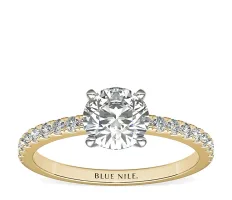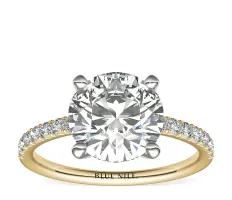18K gold is one of the best choices for an engagement ring, wedding band or other piece of fine jewelry.
A gold karat indicates its purity level. Gold consists of 24 parts, so 24 karat gold represents 100% pure gold. 18 karat gold is made up of 18 parts gold, or, in percentage, 75% gold and 25% other metals, such as silver, copper, and nickel. Compared to either 10K or 14K, 18K gold has a richer, warmer color, making it a good choice if you want your setting to have a rich, impressive color tone.
Because 18K gold contains a higher gold content then either 10K or 14K, it is more expensive. 18K gold will cost about 30% more then 14K and 80% more then 10K gold.
Are you looking to sell your gold? This article is geared towards helping people looking to purchase jewelry. If you are looking to sell your gold, feel free to hop on over to our Selling Your Jewelry page. If you are looking to sell your diamond engagement ring, we have a specific article for Selling Your Diamond Ring
Here’s what we’ll cover in this article:
What is 18K gold?
What is the price of 18K gold?
Is 18K gold pure gold?
What color is 18K gold?
18K white gold: Pros & cons
18K yellow gold: Pros & cons
18K rose gold: Proc & cons
When is 18K gold the right choice?
Our top pics of popular 18K jewelry
FAQs about 18K gold
Why you should trust us

What is 18K Gold?
18 karat gold refers to metal that is made up of 75% pure gold and mixed with 25% of other metals (zinc, nickel, copper and rhodium are the usual choices). The added metal makes 18K gold jewelry stronger and less prone to scratches and warping than jewelry made of pure gold.
In the United States, 10K gold is the lowest level of purity that’s allowed to be marketed as gold. 18K gold significantly exceeds this standard.
18K gold is one of the most popular types of gold used to produce engagement rings, wedding bands and other high-end jewelry. It offers the highest level of gold purity that’s still durable enough to be practical for everyday wear.
Beyond engagement rings and wedding bands, 18K gold is also extensively used in other high-quality products. For example, high-end watchmakers such as Rolex and Patek Philippe make extensive use of 18K gold in their dress timepieces.
Gold is one of the most malleable metals, making it a popular choice for fine jewelry dating back as far as 4,000 B.C.
All gold used in jewelry is categorized using the karat system. Unlike carats, which are a unit for measuring the weight of a diamond or other gemstone, the karat system measures the purity of gold.
The purest gold is rated 24K, meaning that 24 out of 24 parts are pure gold. 18K gold is, as you have probably already worked out, a type of gold that’s 18 parts gold mixed with six parts other materials.
In its pure form, gold is extremely soft. This makes it easy to scratch, which is obviously a huge disadvantage for a piece of fine jewelry. Pure 24K gold is also easy to bend and warp, making it a poor choice for engagement rings, wedding bands and items pieces that are worn daily.
There’s also the color factor. Pure 24K gold is extremely bright and orange, giving it a color that, to most people, is too bright for an engagement ring or other jewelry.
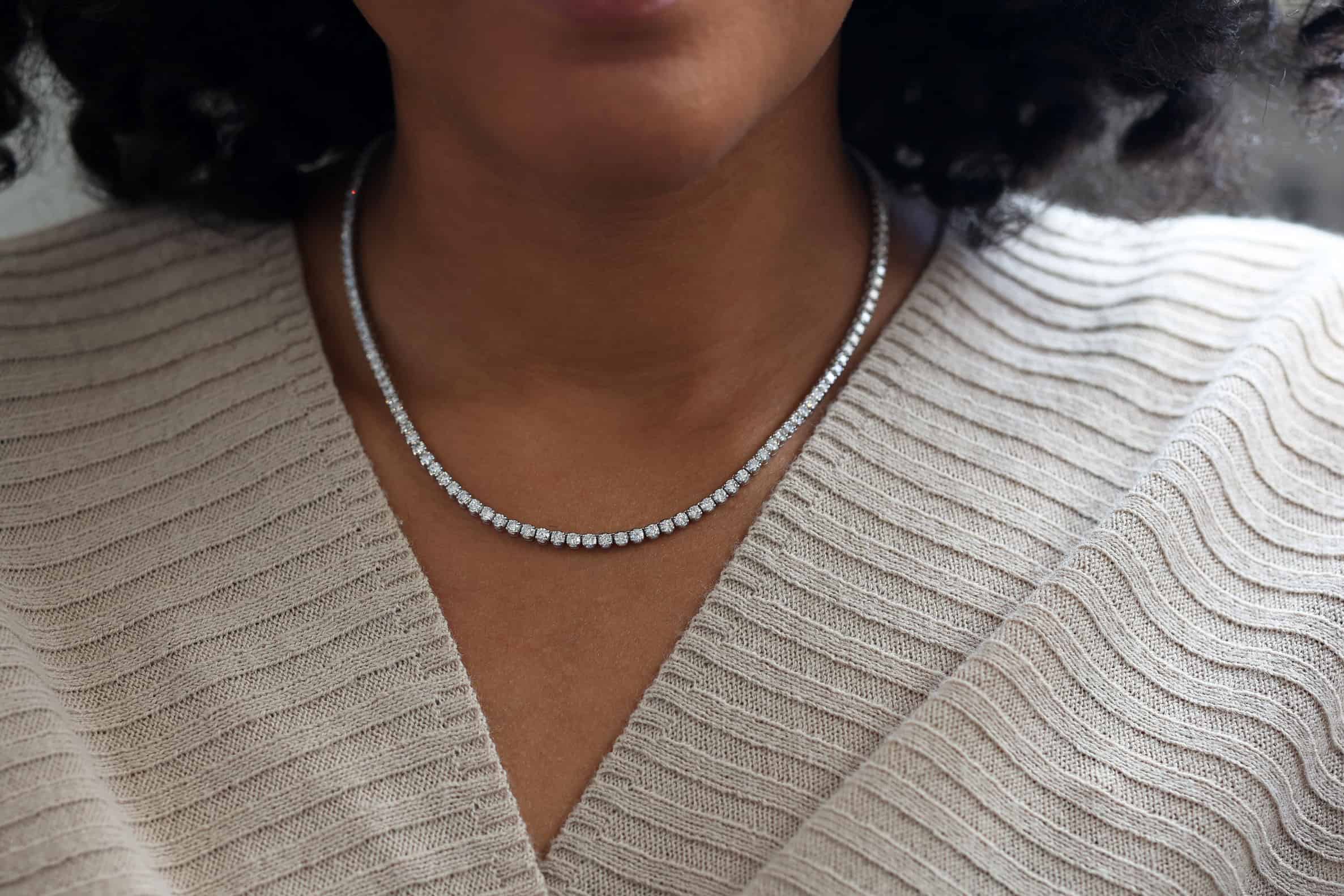
What is the Price of 18K Gold?
Because 18K gold is more pure than 14K and 10K gold, it’s also more expensive. Assuming you choose a simple setting that doesn’t include any pavé or halo diamonds, you’ll generally need to spend about 50 to 150% more for 18K gold as you would for the same setting in 14K gold.
In general, pricing for 18K gold is consistent for all colors. While you might see a small change in pricing between white, yellow and rose gold, it’s uncommon for one color to cost significantly more than another at this purity level.
One important thing to keep in mind is that, as a commodity, the price of gold fluctuates significantly. As the World Gold Council explains, gold has both a spot price and regional prices, meaning the amount you will need to pay for 18K gold jewelry will likely vary based on the specific time you make the purchase and your location.
Gold Offer
This email will go to our contact at Abe Mor who has helped thousands of our readers sell their gold and diamond jewelry. They consistently offer the highest prices for our readers' jewelry. Please include the weights and details of the jewelry. Images are helpful as well.
$0
ValueThis is the current wholesale price of gold. When selling gold you receive a percentage of the price. We recommend asking Abe Mor for a quote as they have consistently offered the highest percentage to our readers.
Get an Offer18K Gold Purity
As we mentioned above, 18K gold is made up of 18 parts pure gold, mixed with six parts other metals such as zinc, nickel, silver and copper. Some types of 18K gold are also plated using a metal called rhodium, a corrosion-resistant element that protects the gold from wear.
18K gold is 75% pure gold. In comparison, 14K gold — another popular type of gold that’s widely used for jewelry — is 58.3% gold. 10K gold, which is typically the least pure, least expensive and most durable form of gold used in jewelry, is just 41.7% pure gold.
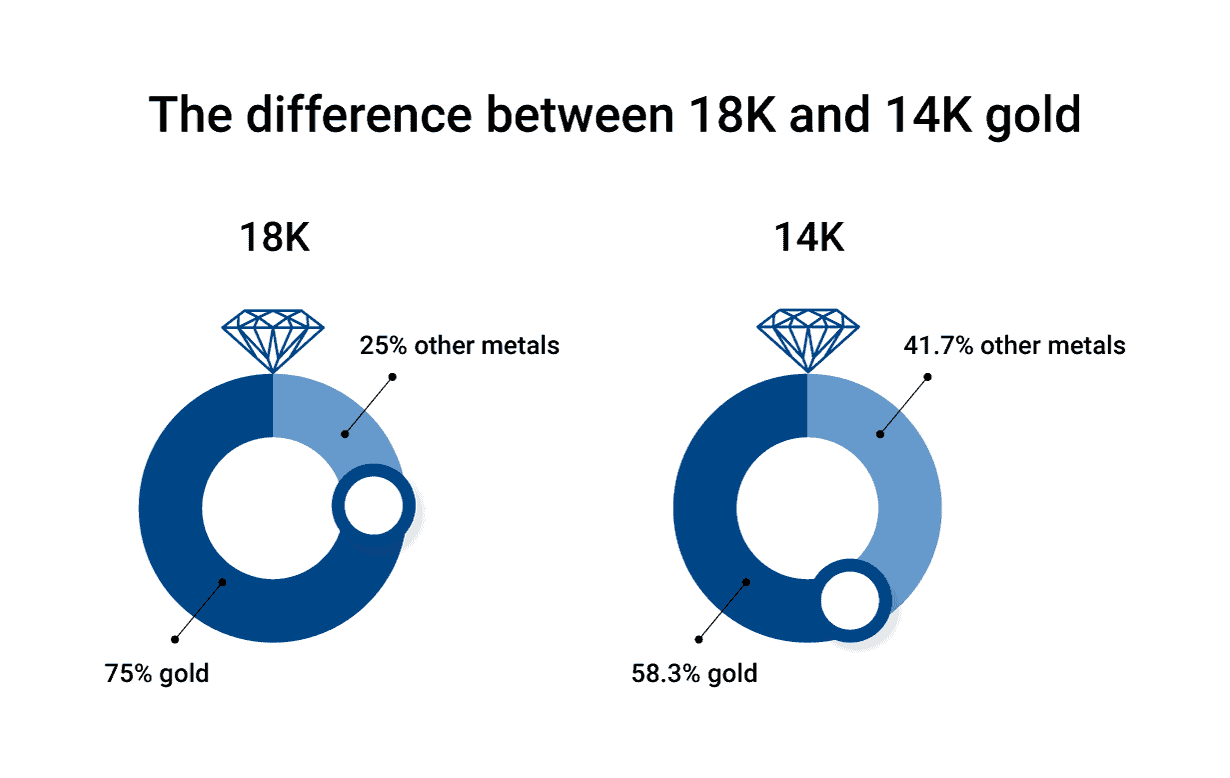
We’ve explained how these purity differences affect the appearance, durability and value of gold in more detail in our 10K, 14K, 18K and 24K gold comparison.
18k Gold Color
As with other types of gold, 18 karat gold is produced in three different colors: white gold, yellow gold and rose gold. Each color has a different chemical composition, with different metals used in different quantities to give each color its unique appearance.
There’s no optimal color for 18K gold, meaning you should choose the color that you think looks the best for you or your fiancé-to-be. To help you make the best decision, we’ve listed several of the main advantages and disadvantages of each 18K gold color below.
18K White Gold
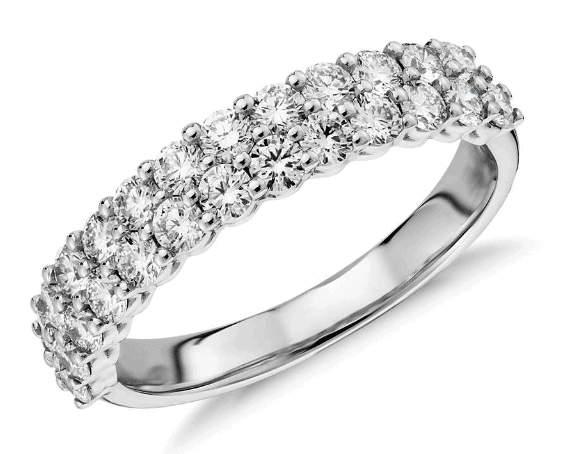
18K white gold is made using a blend of pure 24K gold with other metals such as silver, nickel and palladium. A rhodium coating is applied to most 18K white gold to protect it from corrosion and improve its durability.
Since white gold is an alloy of pure gold and other metals, there’s no such thing as “pure” white gold. All white gold, regardless of its karat number, is an alloy.
Advantages of 18K white gold:
- Currently, white gold is a more popular metal for engagement rings and other jewelry than yellow gold.
- White gold is more affordable than other white metals such as platinum.
- The silver, nickel and palladium used to produce 18K white gold are stronger than the metals used for 18K yellow or rose gold, making this quite a durable, scratch-resistant type of gold, especially when it’s rhodium coated.
- Because white gold has a neutral color, it complements white diamonds without giving them a yellow-looking appearance.
- 18K white gold looks particularly good on people with rosy or fair skin tones.
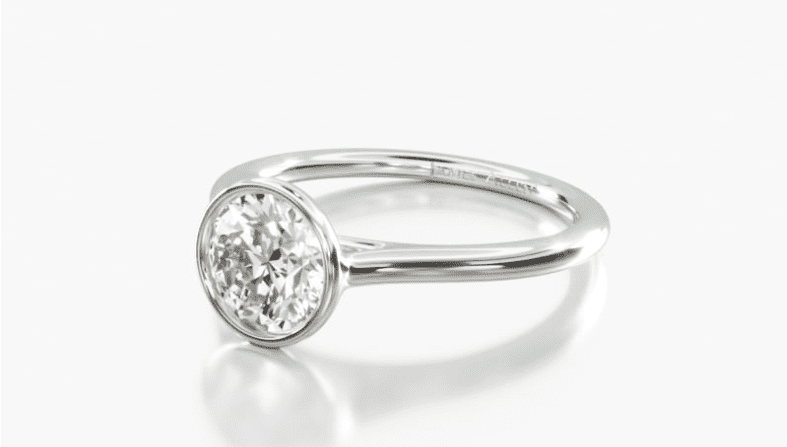
Disadvantages of 18K white gold:
- The rhodium plating used on 18K white gold wears off over time, meaning it needs to be maintained to look its best. If you opt for a white gold ring, you’ll need to have it “dipped” every few years to retain its color, luster and corrosion resistance.
- Most white gold alloys contain nickel, which can cause allergic reactions such as contact dermatitis in some people. If you or your fiancé-to-be have a nickel allergy, you’ll need to check that the white gold used in your ring is mixed with alloys other than nickel.
18K Yellow Gold

18K yellow gold is made using a blend of pure 24K gold and other metals such as copper and silver. Most types of 18K yellow gold are made from 75% pure gold mixed with 12.5% copper and 12.5% fine silver.
Some darker variations of yellow gold are made with a 15% copper content, with silver reduced to 10% of the alloy. 18K yellow gold is one of the most common metals used for rings and other types of fine jewelry.
Advantages of 18K yellow gold:
- 18K gold has the purest gold color of all of the gold types, making it a great option if you want a more classic, conventional color for you or your fiancé-to-be’s engagement ring.
- Because 18K gold has a high purity level, this pure gold color is rich, warm and easy to appreciate, without the slightly dull appearance of 14K or 10K gold.
- Traditionally, yellow gold has been the most popular choice for engagement rings and wedding bands.
- Because of its traditional appearance, 18K yellow gold looks excellent for vintage style settings.
- 18K yellow gold don’t require much maintenance over time to retain its color and luster, making is a good option if you want a ring that’s easy to care for.
- Since this type of gold doesn’t have a rhodium coating, it’s very malleable and easy for jewelers to manipulate.
- Yellow gold complements olive and darker skin tones particularly well, making it a good choice if you or your fiancé-to-be have this type of skin tone.
- Thanks to its warm gold color, yellow gold matches easily with diamonds of a low color grade and can help to hide a yellow color tone in a diamond.
Engagement Ring Inspiration (Click a Ring for More Information)
Disadvantages of 18K yellow gold:
- Although yellow gold doesn’t need to be dipped in rhodium like white gold, it does need to be polished and cleaned every now and then to maintain its appearance.
- While it’s more durable than pure gold, 18K yellow gold is still a fairly easy metal to dent or scratch. As such, you or your fiancé-to-be will need to be careful not to brush the ring against other surfaces.
18K Rose Gold
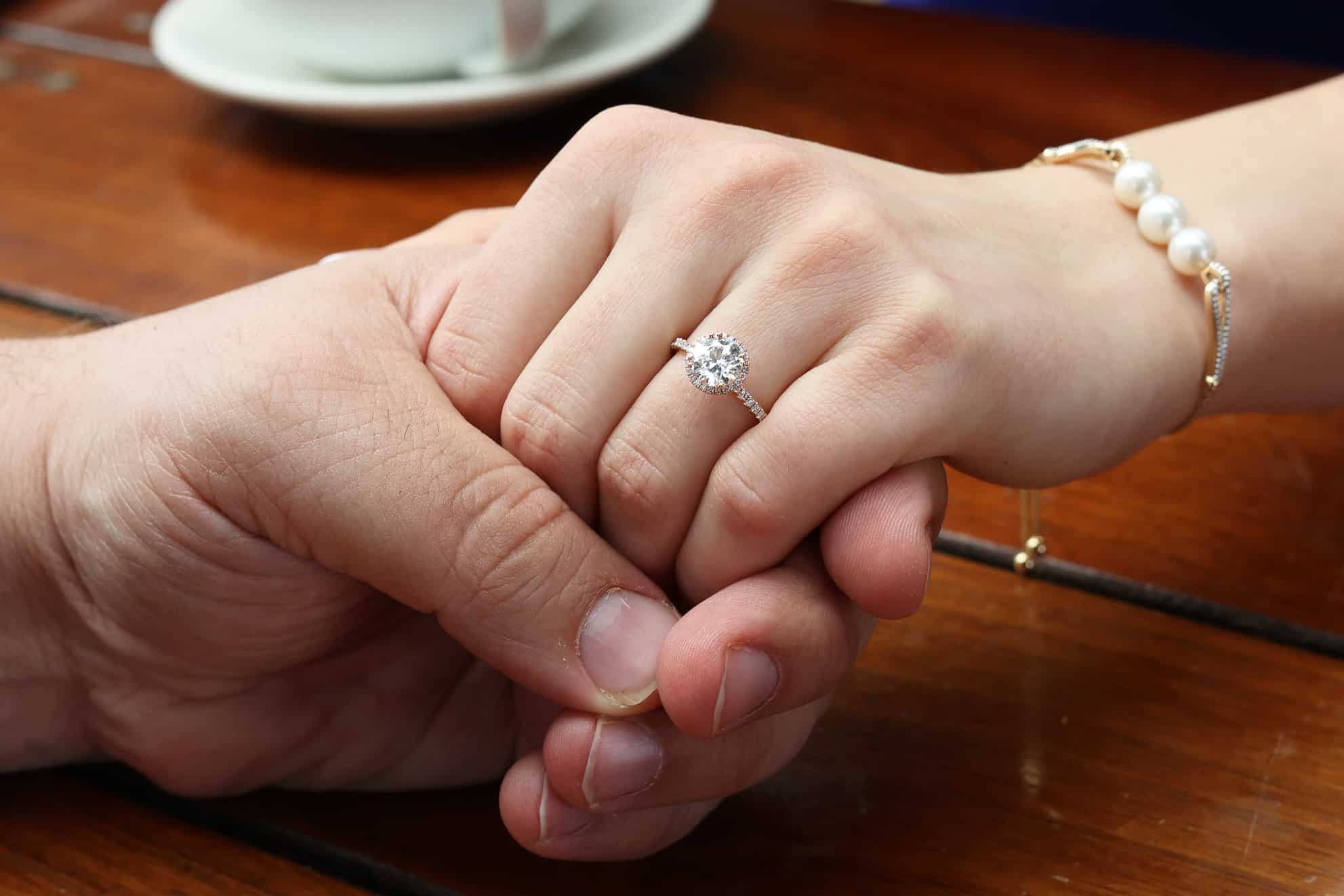
18K rose gold is made using a blend of pure 24K gold and copper. “Rose gold” refers to all red, rose and pink shades of gold. The specific color of rose gold can vary based on the quantity of copper in the alloy — the more copper, the stronger the red color of the gold.
Most of the time, 18K rose gold consists of 75% gold, 22.25% copper and 2.75% silver. 18K red gold doesn’t contain any silver and instead consists of 75% gold and 25% copper. Pink gold has a higher silver content, giving it a lighter tone and a less pronounced red color.
Like white gold, there’s no “pure” rose gold. This type of gold is always an alloy, with the specific color varying based on the ratio of copper to silver.
Advantages of 18K rose gold:
- Rose gold is a stylish, popular choice for both men’s and women’s jewelry. It’s widely considered to be a romantic metal due to its warm, pinkish-red hue.
- As 18K gold has a high purity level, the warm pinkish-red color of rose gold stands out clearly in 18K, particularly compared to 14K and 10K gold.
- Because copper is a relatively inexpensive alloy, rose gold is usually more affordable than white gold, yellow gold and other metals.
- Rose gold is tougher and harder to scratch than yellow or white gold of the same purity level, as copper is a strong, durable alloy.
- Rose gold complements all skin tones, making it a versatile option that can look great people with pale, olive or darker skin.
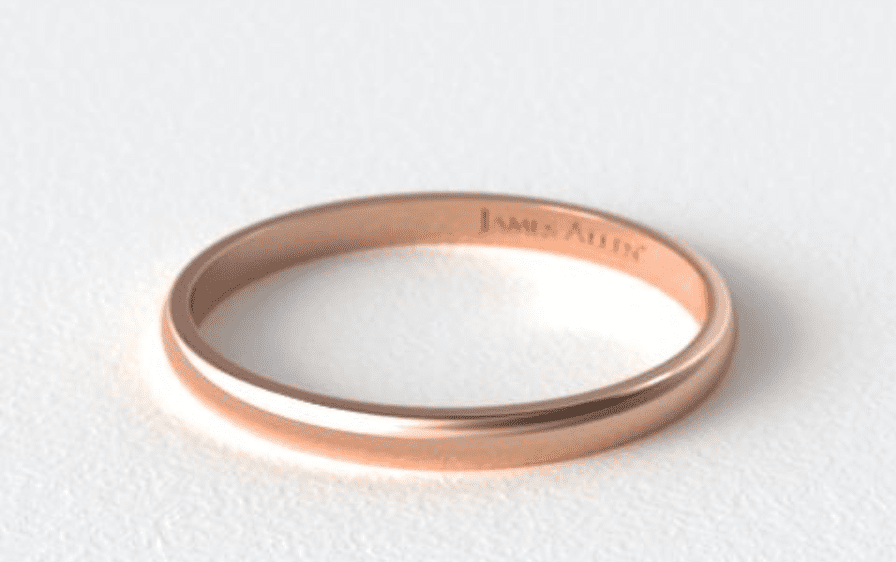
Disadvantages of 18K rose gold:
- While rose gold is less likely to trigger allergies than white gold, but it isn’t a hypoallergenic metal and could still cause skin issues for some people.
- Rose gold, particularly in this purity level, isn’t widely available as an engagement ring metal. For example, Blue Nile carry more than 405 engagement ring settings, but only offer 13 of these settings in 18K rose gold.
When is 18K Gold the Right Choice?
Most engagement rings, wedding bands and other jewelry are made from 14K gold, although 18K gold is also a popular metal.
As a general rule, 18K gold is a good choice for engagement rings, wedding bands and other jewelry if you want the highest possible level of purity while still retaining a reasonable level of durability. However, it’s not always the best choice.
18K gold has a warm, rich appearance. This is most obvious with yellow and rose gold, which both have a deeper hue than the same colors in 14K. If you or your fiancé-to-be are allergic to metals like nickel or copper, 18K gold might also be less likely to cause a reaction.
However, 18K gold is also softer and easier to scratch than 14K gold. If you or your fiancé-to-be have an active lifestyle or work in environments with lots of surfaces that could scratch or dent a ring, 14K gold could be a better choice.
As we mentioned above, there’s also the cost factor. Not only is 18K gold less durable than 14K gold — it’s also about 50 to 150% more expensive.
Popular 18K Gold Jewelry
While 18K gold isn’t the most popular choice for engagement rings and other everyday jewelry, it is a popular choice for earrings, bracelets, and other jewelry that’s worn occasionally.
18K gold engagement ring inspiration
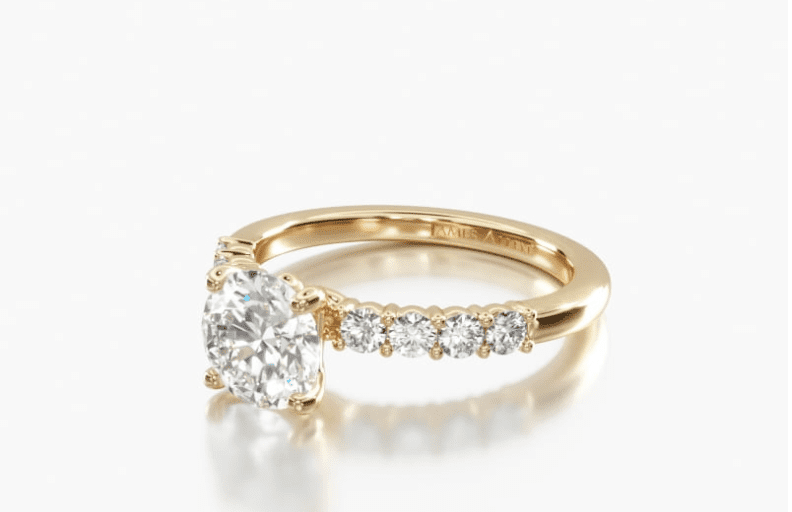
18K bracelets inspiration
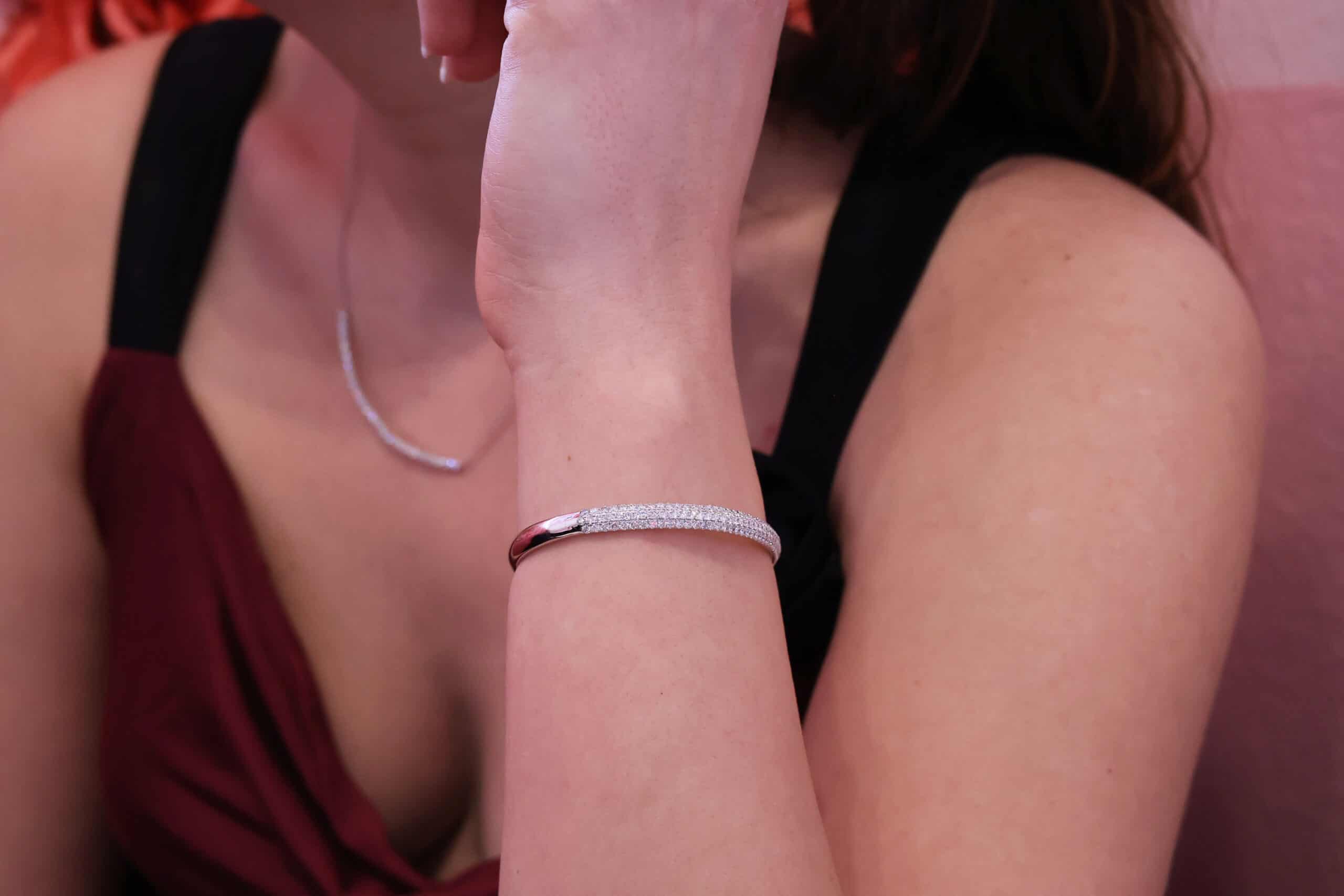
18K gold wedding band inspiration
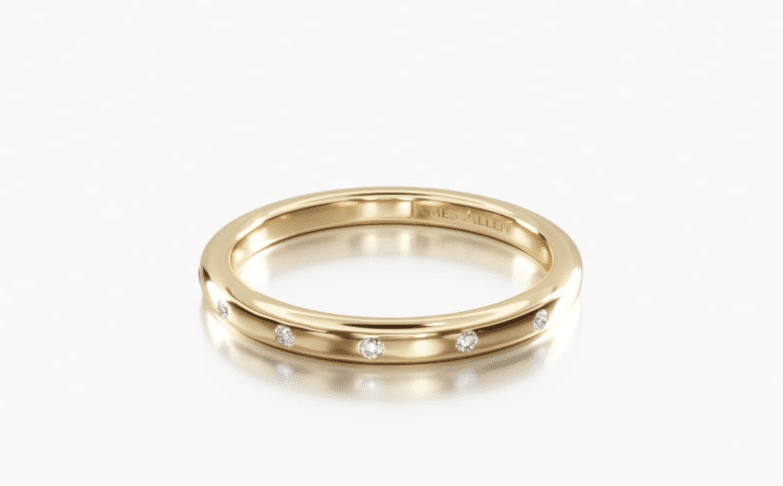
18K earrings inspiration
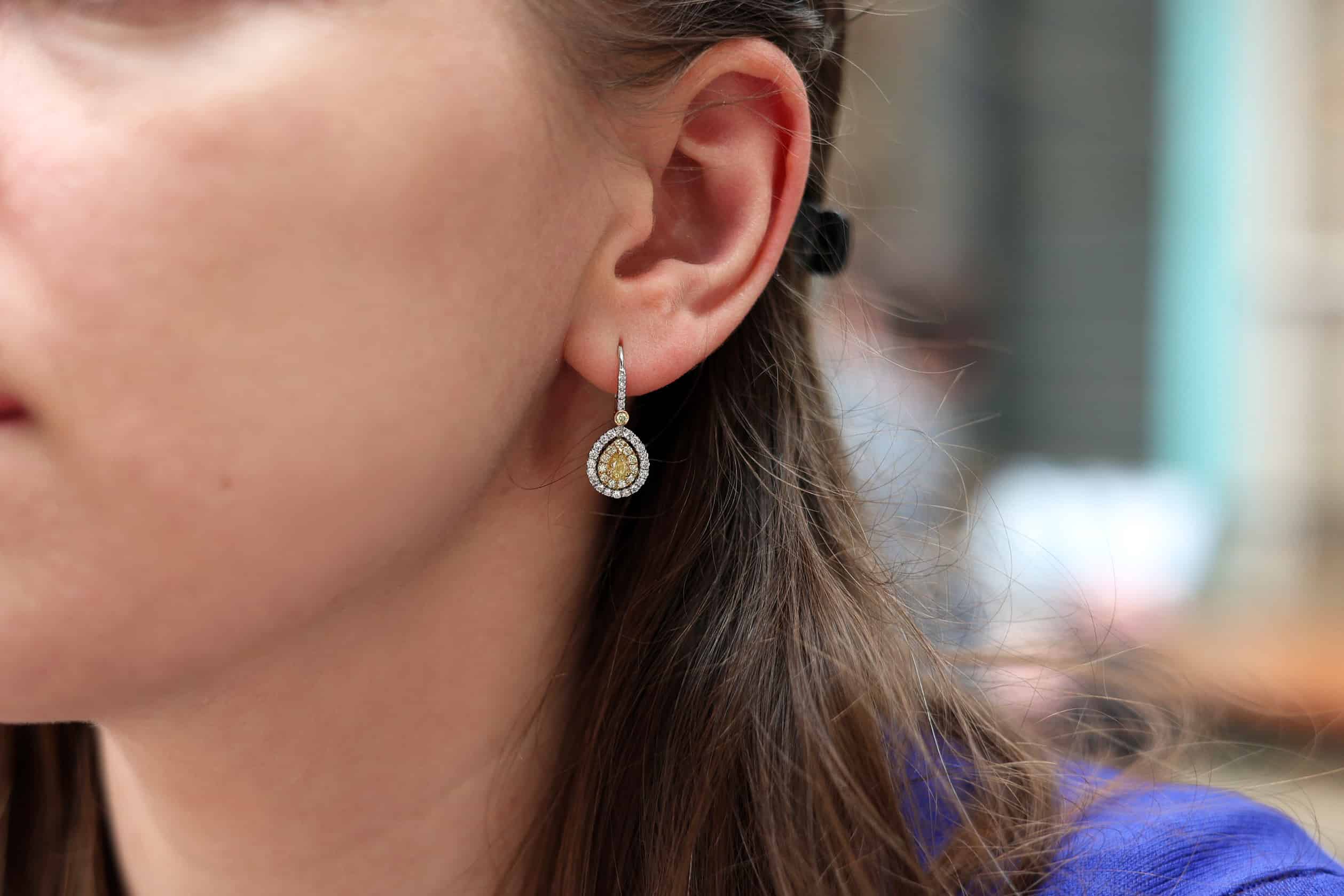
Need help choosing the right type of gold for an engagement ring, wedding band or other piece of fine jewelry? Learn more about 10K, 14K and 18K gold in our comparison guide or reach out to our experts for personalized advice on the best jewelry for your tastes and budget.
FAQs About 18K Gold
18K gold is one of the more expensive types of gold commonly used for jewelry. Though not as expensive as 100% pure solid gold, 18K gold is expensive in its own right.
18K gold is purer, with a higher actual gold content than 14K gold. 18K gold is made up of 75% gold, while 14K is only 58.3% gold.
18 karat gold is very high-quality. It’s extremely pure, it has a rich, warm color, and yet is still relatively durable and scratch-resistant, enough to make it a great choice for gold jewelry.
Gold jewelry, including 18K gold, can be safely cleaned with a mixture of liquid soap and water.
1) Mix some liquid soap with room-temperature water.
2) Soak the jewelry in the mixture for about 15 minutes.
3) Rinse off the jewelry and scrub with a Q-Tip or soft toothbrush
4) Dry
Whether or not 18 karat gold is worth it depends on your budget. If you’re looking for a high-quality ring or piece of gold jewelry, 18K gold can really elevate its look. Yet if you’re on a tighter budget, you can save a decent amount, without too big a drop in quality, by downgrading to 14K gold.
18K gold may tarnish, but it will take a long time to do so. It should tarnish at a slower rate than lower-karat golds, such as 10K or 14K gold, due to its higher gold content.
The main disadvantage of 18K gold is the price. If you’re on a budget, you might find you can save a lot by dropping down to 14K gold. 18 karat gold will also scratch or dent easier, so for those with an active lifestyle, a lower-karat gold may be better.
Yes, you can wear 18 karat gold in the shower. Gold is a durable metal, not easily affected by water. The other alloys present in the metal may be affected, though, which may degrade over time (albeit a long time) with consistent wear in the shower.
18K gold is just right for an engagement ring. Anything above this is generally going to be too soft for an engagement ring. However, if you want a little extra durability, consider going with 14K gold instead.
Bottom Line Recommendation on 18K Gold
Although 18K gold is more expensive than 14K gold, it’s still reasonably priced and offers great value for money. In general, 18K is the highest gold purity level that still remains durable enough for everyday wear, making this the option to go for if you want a pure, durable ring.
Looking for an 18K gold engagement ring? Consider a stunning 18K yellow gold petite pavé ring like this one from James Allen or a beautiful 18K white gold solitaire setting like this one from James Allen. For personalized help, contact our experts and we’ll help you find the best ring or other jewelry for your tastes and budget.
Here are more specific metal topics to browse:
- What is 10K gold?
- What is 14K gold?
- What is 24K gold?
- Which is better: 10K and 14K gold?
- What’s the difference between 14K and 18K gold?
- 10K, 14K, 18K and 24K Gold: What’s the difference?
- How does platinum compare to white gold?
- Which metal is better for wedding bands: platinum or palladium?
- Which metal is BEST for wedding bands?

- No questions asked returns within 30 days of shipment. James Allen will send you a paid shipping label to return the ring.
- Lifetime Warranty
- Free International Shipping
- Free prong tightening, repolishing, rhodium plating and cleaning every 6 months
- Provide insurance appraisals
- One free resizing within 60 days of purchase
- Free ring inscriptions
- Best-in-class high quality imagery of all diamonds in stock
- 24/7 Customer Service
- Best-in-class packaging


- No questions asked returns within 30 days of shipment. Blue Nile will send you a paid shipping label to return the ring.
- Lifetime Warranty
- Free Shipping
- Free prong tightening, repolishing, rhodium plating and cleaning every 6 months
- Provide insurance appraisal
- One free resizing within the first year of purchase
- High quality images of about half of their diamonds
- 24/7 Customer Service
- 100% credit towards future upgrades (must be at least double in value)
- Best in class fulfillment

Still afraid of getting ripped off?
Before you buy a diamond, get personal buying advice from industry veterans. We'll help you get the best diamond for the money.
Ask your diamond purchase question here
DISCLAIMER: We don't use your email for marketing. Period.
You Might Like
Diamond Prices: A Complete Guide
A diamonds’ price is determined primarily by the 4 Cs of the diamond. On the wholesale level, diamond prices are first based on a diamond shape and
The Best Places to Buy Engagement Rings
Buying an engagement ring is often one of the first major purchases in a person's life. The process can be fraught with tension as there are so m
1 Carat Diamond Price & Buying Guide
A wide range of 1 carat diamonds exist both in online markets and local diamond jewelry stores. Not only are there significant differences in beauty

